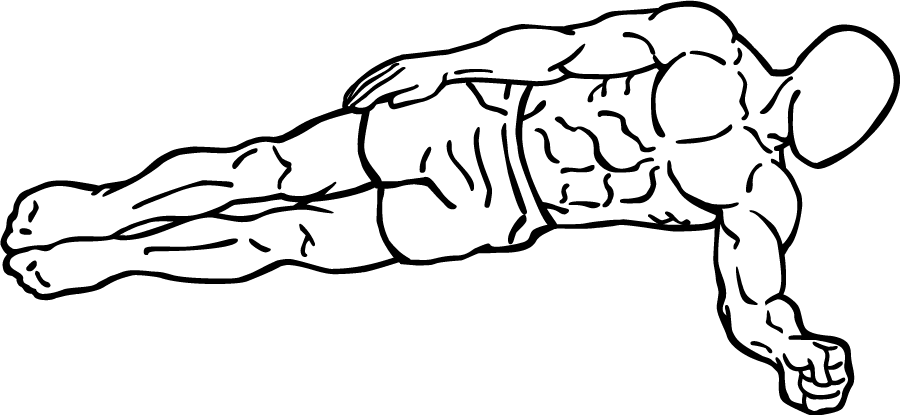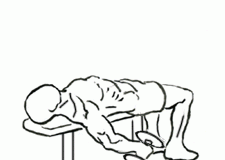Last Updated on September 20, 2014
When we think about core exercises, traditional planks, crunches, and sit-ups often come to mind. However, if you’re looking to build a truly balanced and resilient core, the side plank is a foundational move that deserves your attention. Unlike more common core exercises that target the front abdominal muscles, the side plank strengthens the obliques, the deep core muscles, and the stabilizers of the spine, creating a stronger, more balanced core and improving your body’s overall stability. For athletes, fitness enthusiasts, or anyone interested in a functional approach to fitness, the side plank is a must-have in any core routine.
In this article, we’ll delve into what makes the side plank so effective, how it works the muscles of the core in a unique way, and why it’s one of the best moves you can add to your workout for improved strength, balance, and posture. Whether you’re new to exercise or looking to enhance your core routine, mastering the side plank can unlock a new level of fitness and functionality.
Why the Side Plank?
The side plank is a static exercise that requires you to hold your body in a lateral position using just one forearm and the edge of your feet for support. This move activates your core muscles in a way that no other core exercise does. By stabilizing your body in this position, you engage the obliques and transverse abdominis—two key muscles responsible for core stability—as well as the glutes and lower back muscles that help prevent the spine from rotating. Unlike exercises that isolate one specific part of the core, the side plank works your body as a whole, helping to create balanced muscle development.
Moreover, the side plank offers benefits beyond aesthetics. It plays a crucial role in injury prevention, particularly in the lower back, by strengthening the stabilizing muscles of the torso. A stronger core reduces strain on the back, promotes better posture, and allows you to perform everyday movements with greater ease and precision. If you’re aiming for a solid foundation for more complex exercises, like deadlifts or squats, side planks can help build the strength and stability you need to perform them safely.
Setting Up for the Side Plank
To begin, position yourself on one side, lying down with your legs extended straight. Stack your feet one on top of the other, aligning them so that your entire body is in a straight line from head to feet. Place your lower forearm on the floor directly under your shoulder, keeping it perpendicular to your body. This alignment is essential for maintaining stability and ensuring that your shoulder, core, and legs are all working in unison. Rest your upper arm along the side of your body or place it on your hip.
Take a moment to center yourself. Before initiating the lift, engage your core by drawing your belly button toward your spine. This will activate the transverse abdominis, the muscle responsible for core stability, which provides a stable base for your body as you rise.
Executing the Side Plank: Lifting into Position
With your body aligned, it’s time to move into the side plank. Begin by pressing through your forearm and the side of your bottom foot to lift your hips off the ground. As you lift, imagine creating a straight, diagonal line from your head to your feet. The aim is to keep your body as stable as possible, with no sagging or rotating. Hold your core tight, keeping your glutes and legs engaged to maintain a balanced posture. Focus on drawing your abs inward to support your spine and help you remain steady.
This position—where your body weight is distributed between your forearm and feet—places significant demand on your obliques, the muscles running along the sides of your torso. By holding the position, you’re developing not only strength but also endurance, training your core to withstand external forces and sudden shifts in balance. It may be challenging initially, but with practice, your body will adapt, and you’ll feel an increase in core stability and strength.
Maintaining Form: How to Hold the Position
The effectiveness of the side plank lies in your ability to maintain form, so focus on stability rather than duration initially. Hold the side plank for as long as you can maintain good form, starting with 15 to 20 seconds per side if you’re a beginner. If you’re more advanced, aim to hold for 30 seconds to a minute or longer as you build endurance.
While holding the side plank, keep your neck aligned with your spine to avoid unnecessary strain. Look straight ahead or down at your hand to prevent your neck from tensing up. Remember to keep your body in a straight line—this means no dipping at the hips or arching at the shoulders. The goal is a solid, diagonal line from head to feet, with all muscles working together to hold the position.
Lowering Back Down: Completing the Move
Once you’ve reached your desired hold time, lower your hips back to the ground with control, maintaining engagement in your core until you’re fully resting on the exercise mat. Take a brief moment to relax before repeating the movement on the other side. Alternating sides ensures both obliques and stabilizers are engaged equally, contributing to balanced strength throughout the core.
To get the full benefit of this exercise, repeat the side plank two to three times on each side, allowing for short rest intervals between sets. As you progress, you can increase the hold time or the number of repetitions to continue challenging your muscles.
Benefits of the Side Plank
The side plank is one of the most beneficial core exercises due to its effectiveness in strengthening multiple muscle groups simultaneously. Here are a few of the key benefits:
- Improved Core Stability: The side plank strengthens the entire core, helping stabilize the spine and promoting functional strength that translates to better movement in daily life.
- Enhanced Posture: By strengthening the muscles that support the spine, the side plank promotes better posture, reducing the tendency to slouch and improving alignment.
- Reduced Lower Back Pain: A strong core relieves pressure on the lower back, helping to prevent and alleviate back pain that can result from muscular imbalances or a sedentary lifestyle.
- Better Athletic Performance: Core stability is foundational for almost every sport, and side planks improve balance, agility, and the ability to generate power from the torso, which is essential for activities like running, tennis, and golf.
- Injury Prevention: The obliques play a crucial role in rotational stability, especially in activities that involve twisting or turning. Side planks strengthen these muscles, making you less susceptible to strains and injuries.
Tips for Mastering the Side Plank
To make the most of the side plank, here are some tips to help you maintain form and maximize results:
- Engage Your Core: Draw your belly button inward and engage your abs throughout the movement. This will help prevent your hips from sagging and keep your core stable.
- Focus on Quality Over Duration: It’s better to hold the side plank with perfect form for a shorter time than to hold it for a long time with poor alignment. As your strength builds, gradually increase your hold time.
- Stack Your Feet: For stability, keep your feet stacked. If you find balancing challenging, you can stagger your feet with the top foot slightly forward for added stability until you’re ready for a full stack.
- Experiment with Arm Position: While the standard position is to place your upper arm on your hip, extending your arm straight up toward the ceiling can add an additional balance challenge and open up the chest, improving shoulder stability.
Variations to Increase Challenge
As you progress with the side plank, you can introduce variations to make the exercise more challenging:
- Raise the Top Leg: Lifting your top leg while holding the side plank adds an additional challenge, engaging the glutes and outer thighs for extra stability.
- Side Plank with a Twist: This variation involves rotating your torso and reaching your upper arm underneath your body, adding a dynamic movement that enhances core engagement and challenges the obliques even further.
- Weighted Side Plank: Adding a light dumbbell in your upper hand can increase the difficulty and build more strength in the shoulder and core.
- Side Plank on an Unstable Surface: Performing a side plank with your forearm on a stability ball or balance pad will require greater stabilization from the core and enhance balance.
Integrating the Side Plank into Your Routine
The side plank is highly adaptable and can be incorporated into almost any core or total-body workout. For those focusing on core strengthening, use the side plank toward the end of your core workout routine to exhaust the obliques and stabilizers. If you’re using the side plank as a warm-up exercise, a shorter duration of around 15 to 20 seconds per side can help activate the core without overexertion.
For balanced results, aim to perform side planks two to three times a week, allowing adequate rest for your muscles to recover. Consistency is key, and by practicing the side plank regularly, you’ll develop core strength and stability that support all areas of your fitness journey.
Final Thoughts on the Side Plank
The side plank may appear simple, but its benefits for core strength, stability, and overall functional fitness are profound. With consistent practice, you’ll notice enhanced balance, better posture, and improved resilience against injuries. Plus, the exercise is adaptable, allowing you to start with a basic side plank and progress to advanced variations that continue to challenge and build your core strength.
Adding the side plank to your workout routine is a smart step toward achieving a well-rounded, balanced core. Whether you’re an athlete looking to improve performance or someone aiming for better functional fitness, the side plank is a powerful exercise that helps you build a solid foundation for movement, strength, and stability. So, next time you’re working on your core, don’t overlook the side plank—your body will thank you for it.








